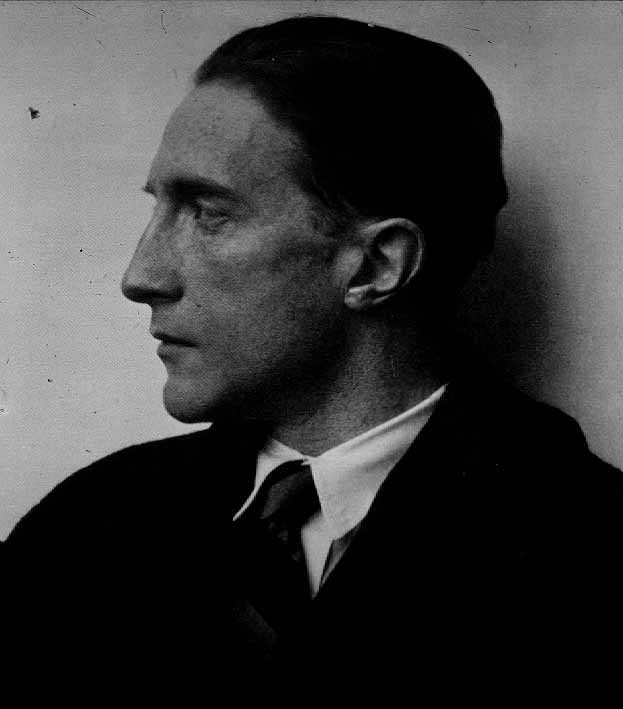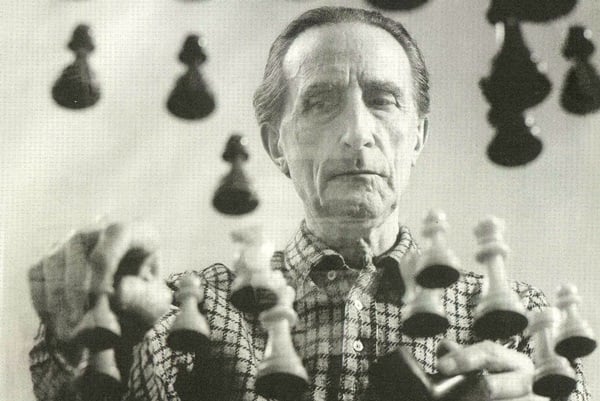|\| ART BLOG HUMOR BLOG PHOTO BLOG CULTURE BLOG |:| FOR THE RENAISSANCE MAN & THE POLYMATH WOMAN |/|
Tuesday, July 28, 2015
7 Reasons to Celebrate Marcel Duchamp on His Birthday
People


7 Reasons to Celebrate Marcel Duchamp on His Birthday

Marcel Duchamp.
Photo: Courtesy of University of Southern Califórnia
Photo: Courtesy of University of Southern Califórnia
Marcel Duchamp was a prankster, a rabble-rouser, and an envelope pusher. Over a century after he plunged a bicycle wheel into a four-legged stool, artists are still paying homage to his life and work.
At the time, however, not all collectors were happy with his readymades. According to Tout-Fait, the Marcel Duchamp Studies Online Journal, Dorothea Dreier commissioned Duchamp to create Why Not Sneeze, Rrose Selavy? (1921) for $300; when he submitted the work, she apparently hated it and gave it to her sister, who later sold it to collector Walter Arensberg without a profit. (It's now in the Philadelphia Museum of Art's permanent collection.)
The artist, who passed away in 1968, always had a sense of humor about his work and ensured that no one could map out his oeuvre without noticing his tricks. For example, his 1964 Fountain is a "hand-crafted, editioned, gallery-sanctioned, sort-of-signed simulation of the functional urinal" that Duchamp originally presented to the viewing public in 1917.
Here are seven reasons why we love the artist, on what would be his 128th birthday.
1. Duchamp on art: "I was very happy when I discovered that I could introduce humor into it."
2. Duchamp on his feminine alterego, Rrose Sélavy: "I decided that it didn't suffice me to be a lone individual with a masculine name, I wanted to change my name in order to change, for the ready-mades above all, to make another personality from myself."
3. Duchamp on influences: "The first thing to know: one doesn't realize one is influenced. One thinks he is already liberated and one is far from it!"
4. Duchamp on "reverse readymades": "That would be to take a Rembrandt and to use it like an ironing board."
5. Calvin Tomkins on Duchamp: "He spoke about how he doubted everything and, in doubting everything, found ways to come up with something new."
6. Duchamp on his Impressionist stage: "When you are 15 and painting like the Impressionists, you are experimenting with yourself… It took me ten years or more to change the style [and] I tried to find something else."
7. Duchamp on Bicycle Wheel (1913): "I enjoyed looking at it, just as I enjoy looking at the flames dancing in a fireplace."

Duchamp plays John Cage in Toronto, 1968.
Photo: via zettelmagazine.com.
https://news.artnet.com/people/7-reasons-celebrate-marcel-duchamp-birthday-318147
Photo: via zettelmagazine.com.
https://news.artnet.com/people/7-reasons-celebrate-marcel-duchamp-birthday-318147
concrete-cast ceramics || raised floor
http://www.frameweb.com/news/yusuke-seki-stacks-concrete-cast-ceramics-inside-the-maruhiro-flagship?utm_source=newsletter-28-jul-2015&utm_medium=email&utm_campaign=news&utm_content=news5image
Yusuke Seki stacks concrete-cast ceramics inside the Maruhiro flagship
For over four centuries, a rich history in the production of pottery and porcelain sustained Japan’s Hasami region’s reputation as the source of the traditional tableware. Charged with redesigning the flagship’s interior, architect Yusuke Seki literally elevates artisanal ceramics to a whole new level inside the Maruhiro flagship.
Sourced from the kiln disposal areas of local factories, nearly 25,000 ceramic pieces with imperfections made during the bisque and firing processes were collected and then cast into concrete. The cloned assortment of chipped cups and plates – known as 'Shinikiji' in their ceramic state – were stacked in a brick-like fashion to produce a platform reaching a half metre in height. Accessed with steps, the raised floor becomes the showroom, with impeccable versions of the authentic cups and bowls displayed upon freestanding wooden displays. Despite the tableware's individual fragility, the collective unit acts as a strong foundation – a symbolic message for the region's history as well as the Maruhiro brand.
Photos Takumi Ota
yusukeseki.com
hasamiyaki.jp
Sourced from the kiln disposal areas of local factories, nearly 25,000 ceramic pieces with imperfections made during the bisque and firing processes were collected and then cast into concrete. The cloned assortment of chipped cups and plates – known as 'Shinikiji' in their ceramic state – were stacked in a brick-like fashion to produce a platform reaching a half metre in height. Accessed with steps, the raised floor becomes the showroom, with impeccable versions of the authentic cups and bowls displayed upon freestanding wooden displays. Despite the tableware's individual fragility, the collective unit acts as a strong foundation – a symbolic message for the region's history as well as the Maruhiro brand.
Photos Takumi Ota
yusukeseki.com
hasamiyaki.jp
 |
2015 Deutsche Börse Photography Prize
MMK exhibits works by the finalists for the 2015 Deutsche Börse Photography Prize | |||||||||
This year’s choice of finalists reflects the diversity of approaches in the field of photography, ranging from video works via social documentary pictures to portrait photography. Nikolai Bakharev’s work focuses on the tensions between the public and private spheres. His photographs of Russian bathers on public beaches in the 1980s and 1990s allude to the hypocrisy of official policy, making reference to what images were or were not permitted in the former USSR. In Zanele Muholi’s portraits and in her photographs of members of the LGBTI community in South Africa there is a blurring of the private and the political. Political and social transformations in South Africa are also at the heart of the work by Mikhael Subotzky and Patrick Waterhouse. In their joint work they present an album of pictorial and textual material recording the history of a high-rise building in Johannesburg, once exclusive and still iconic but now run-down and largely occupied by squatters. The other finalist represented in the MMK 3 exhibition is the contemporary photographic artist Viviane Sassen, whose images play with the boundaries of photography and sculpture. The Deutsche Börse Photography Prize is an annual award, established by the Photographers' Gallery in London in 1997 and since 2005 presented each year in association with the Deutsche Börse Group. The prize, worth £30,000, is awarded to a contemporary photographic artist who in the preceding year made a significant contribution to photography in the form of an exhibition or publication in Europe, and it is regarded as one of the most prestigious international art prizes. This year’s judges are Chris Boot, Executive Director of the Aperture Foundation; the artist Rineke Dijkstra; Peter Gorschlüter, Deputy Director of the MMK Museum für Moderne Kunst, and Anne Marie Beckmann, Curator of the Art Collection Deutsche Börse. The winner was announced at an award ceremony held at the Photographers' Gallery on 28 May 2015. | |||||||||
video || Cézanne's Montagne Sainte Victoire
In Focus on Paintings: Cézanne's Montagne Sainte Victoire
| |
Subscribe to:
Comments (Atom)








